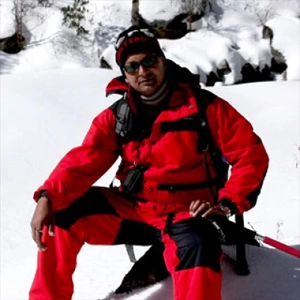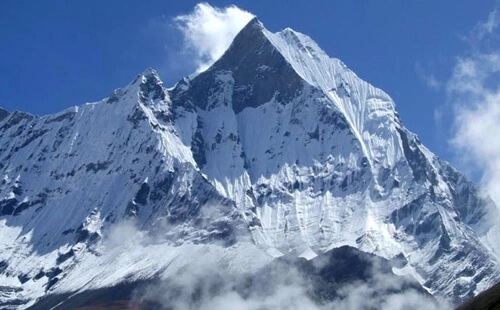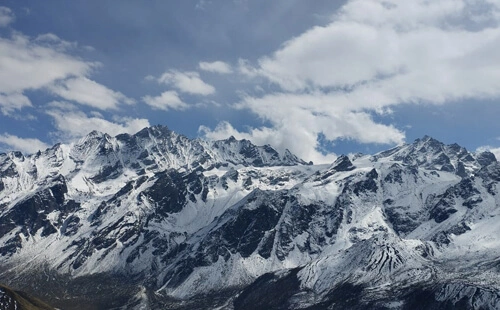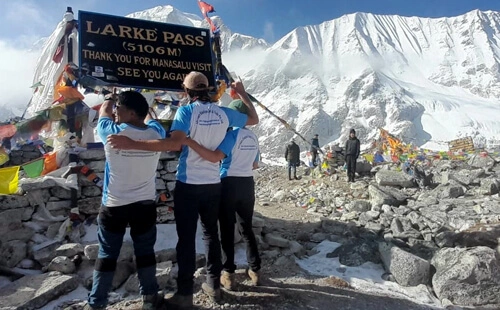Annapurna Base Camp Trek vs Everest Base Camp Trek: Geographical Beauty and Landscape Variation
The journey to Annapurna Base Camp (ABC) moves on through the Annapurna area, the conservation area providing the region’s tempting beauties as one goes through from the potherb lands of rhododendron, oak, and pine forests, the cultivation slopes, traditional Nepali houses of Gurung, and up to the smooth pastures, backed by snow-clad Himalayan ranges.
Annapurna massif, the 10th highest Himalayan mountain, Annapurna I (8,091 m), is the primary attraction of the entire trip to the Annapurna Base Camp that can be partially or fully seen from various highlands, including Annapurna I, II, III, and IV, Machhapucahre (fishtail), and Dhaulagiri, especially from the base camp itself at an altitude of 4,130 m.
The trekking trail to the Everest Base Camp (EBC) is renowned for its rugged, alpine landscapes with wide stretches of glaciers and almost desert-like terrain, marking the proximity to the south base camp in Nepal at 5,364 m/17,598 ft. The journey provides various perspectives of Mount Everest (8,848 m), the closest view from Kala Patthar, and an embrace of its true serenity.
Additionally, the panoramic sight of other massive peaks like Lhotse, Nuptse, Ama Dablam, and others adds much to the visual splendor in stark contrast to the landscapes of Annapurna entering deep into the Khumbu valley with the occasional striking sight of Khumbu glacier.
Cultural Experience during the Annapurna Base Camp (ABC) and Everest Base Camp (EBC)
The Annapurna Trekking region consists of many different ethnic cultures in the 7,629-square-kilometer area in Nepal. Villages on the way to ABC, such as Ghorepani, Tadapani, Ghandruk, and Chhomrong, are however dominated by Gurung and Magar, with young off to the military.
Trekkers, visitors, and travelers will have plenty of opportunities to engage with the locals, learn about the Himalayan way of life, and even take part in their unique festivals and celebrations in the quaint little villages that still maintain their ancient cultures, traditions, and customs.
Where, the EBC Trek is famous for the Sherpa people, whose culture has strong grounds in the Tibetan belt of Buddhism. The Sherpas acknowledged internationally for their wonderful talents of alpine, commonly referred to as ‘tigers of snow', add much to the cultural immersion and are especially courteous and hospitable. Therefore, Trek to Everest Base Camp is a favorable chance to introduce you to Sherpa’s culture and their way of life.
Strolling past several important historical, cultural, and religious sites will be an incredible experience. One such site is the Tengboche monastery, which is regarded as the biggest in the area and serves as a spiritual hub amidst the stunning views of Mount Ama Dablam. As a result, the trekking route to the EBC provides a window into Sherpa culture, which is closely entwined with the natural world and the mountains.
Accessibility to ABC and EBC
Though both the trekking routes are accessible via land, it might not be practical to reach Everest Base Camp overland, requiring a mountain flight from Kathmandu to Lukla, otherwise also known as one of the most daring airports in the world. The flight is competitively short and scenic, but it is also often erupted by weather conditions, sometimes also leading to delays.
Therefore, reaching Nayapul, the starting point for Annapurna Base Camp (ABC), might be more accessible than EBC, which is a short drive from Pokhara, a bustling tourist hub of Nepal well connected by road and air from the capital city of the Himalayan nation, Kathmandu. The joyous ride lasts 7-9 hours depending upon the traffic of the day along the bank of the Trishuli River following the Prithivi Highway, or you can opt for a 20-minute flight as well.
Altitude and difficulty levels of ABC and EBC
During the Annapurna Base Camp Trek, the highest altitude you will reach is the base camp itself at 4,130 m, which is otherwise for the Everest Base Camp (EBC) expedition. Usually, trekkers arriving at the base camp of Everest also take a side trip to one of the spectacular vantage points of the Everest Trekking region called Kala Patthar (approx. 5,545 m) for more expansive views of the surrounding Himalayas, including Mt. Everest (8,848), making it the maximum evaluation expeditors reach.
In conclusion, both the ABC and EBC are comparable high-altitude hikes in the great Himalayas, which implies awareness of ascending to low oxygen levels, steep climbing/descending, and through some of the glacial terrains to the higher reaches of the Himalayan mountain range. However, since the maximum altitude reached during the EBC exceeds 5,000 m, it is considered more demanding in terms of altitude, physical exertion, and risk of altitude sickness, hence, the trek to Everest Base Camp is considered much more challenging than the trek to Annapurna Base Camp (ABC).
Trekking and Hiking duration: Annapurna Base Camp VS Everest Base Camp
The standard Annapurna Base Camp Trekking route in common covers approximately 110km and can be completed typically in around 7 to 12 days, while the hiking to the Everest Base Camp (EBC) is 130km and generally takes 12 to 16 days. The exact number of trek days and distance may vary based on the starting and ending points and the number of days allocated for acclimatization along with the itinerary.
Nonetheless, the trek to Annapurna Base Camp (ABC) is generally shorter in duration than EBC, making it an ideal option for those with a tight schedule seeking a moderately long Himalayan experience, while trekkers can also choose to embark through various routes that may bring some alteration in the number of days during these popular treks in the Nepalese Himalayas.
I.e., the Everest Base Camp Trek by helicopter is relatively shorter, and if you combine the EBC trek with other major highlights of the region, such as Three High Passes, Gokyo Lakes, and others, it gets comparatively longer, which, as per ABC, you can include visiting Annapurna Circuit to mark the victory over Thorong La Pass along the deepest gorge in the world, Kali Gandaki, or meander around the sacred shrine of Muktinath.
Accommodation, food, and other amenities during the Trek to Annapurna Base Camp and Everest Base Camp
While both the popular Himalayan trekking routes feature well-established tea houses, lodges, and guest houses, usually with simply furnished shared rooms with twin beds, mattresses, pillows, and blankets, due to the more remote and longer trek days in the high altitude, the services may get more basic during the EBC Trek.
You can expect quality tea houses with hot showers and toilets outside of the room, WiFi, bottled drinking water, and charging facilities at some additional cost on both trails. Still, they might be more widely available and affordable on the ABC trail than on the Everest route. That makes up for it, though, with a unique stay in the remote Sherpa villages.
Similarly, the menus on both adventurous routes can go from some international options like pizzas, burgers, and pancakes in comparatively lower altitudes and larger villages to simple, dal bhat, noodles, pasta, soups, and bread, staple choices as you ascend to higher altitude areas, which nonetheless are nutritious, reliable, and filling enough required for a fulfilling journey towards ABC and EBC.
Crowds in Annapurna Base Camp (ABC) VS Everest Base Camp (EBC)
Everest Base Camp, one of the most popular treks in the world, can get extremely crowded, especially during the peak seasons of spring and autumn from March to May and September to November. The favorable weather conditions for every sort of adventure, be it climbing to the summit of the peak, trekking, or helicopter tour, attracts hundreds of hikers every year, so you can expect to meet large groups of trekkers, hikers, and expeditors as they travel the globe.
As per the Annapurna Base Camp Trek, though it is equally popular, it can be typically less congested than the trek to Everest Base Camp, particularly during the off-seasons, monsoon/summer, and winter, providing a more serene and peaceful experience. Often, several trekking, tour, and expedition operators, such as Adventure Himalayan Travels and Treks, offer discounted prices on the package as well, making it a budget-friendly option to consider.
Permits for Annapurna Base Camp (ABC) VS for Everest Base Camp (EBC)
It is crucial to know that both the Annapurna Base Camp Trek (ABC) and Trek to the Everest Base Camp (EBC) enter the respective conservation areas: the Annapurna Conservation Area and the Sagarmatha National Park; hence, it is essential to acquire appropriate permits, which are regulated by the government of Nepal itself, to promote sustainable tourism and contribute to the environment, monitor tourist activities, and provide aid in need.
For the ABC trek, you will need the Annapurna Conservation Area Permit(ACAP) along with a standard Trekkers Information Management System (TIMS) card, which is otherwise a local Khumbu Pasang Lhamu Rural Municipality Entry Permit and Sagarmatha National Park Entry Permit for the Trek to Everest Base Camp (EBC).
Trek to Annapurna Base Camp (ABC) Cost VS Everest Base Camp Trek Cost
Although the total cost for both the Himalayan trip to Annapurna Base Camp (ABC) and Everest Base Camp (EBC) may vary based on your personal preferences, sending habits, group size, and your trek organizers, usually the EBC trek is costlier due to the longer duration and higher altitude in the remote Khumbu region.
During the Everest Base Camp (EBC) Trek, most trekkers fly over to Lukla, and the price of the goods tends to go higher in the high altitude, with more expensive amenities adding much to the package cost itself. But, for the ABC trek, a flight to Pokhara might not be necessary as it is easily accessible by road, which cuts down on expenses significantly.
Conclusion
While both the trek to Annapurna Base Camp (ABC) and Everest Base Camp (EBC) feature their distinctive charms with equally stunning views and unique Himalayan experiences, it is completely an individual choice on which could be the best one for you.
For novices or adventurers seeking a comparatively easier, lower altitude, shorter yet diverse experience, the Annapurna Base Camp Trek (ABC) could be the fantastic option, while the Everest Base Camp is mostly likely to cater to the interest of someone wishing to be at the shadow of the world’s tallest peak, ideal for those prepared for every aspect of a classic Himalayan challenge.
Nonetheless, both treks offer an unparalleled adventure, gorgeous mountain views, natural beauty, cultural richness, and a sense of accomplishment, but the best choice can vary based on your fitness level, time, budget, desired adventure, and personal preferences.




